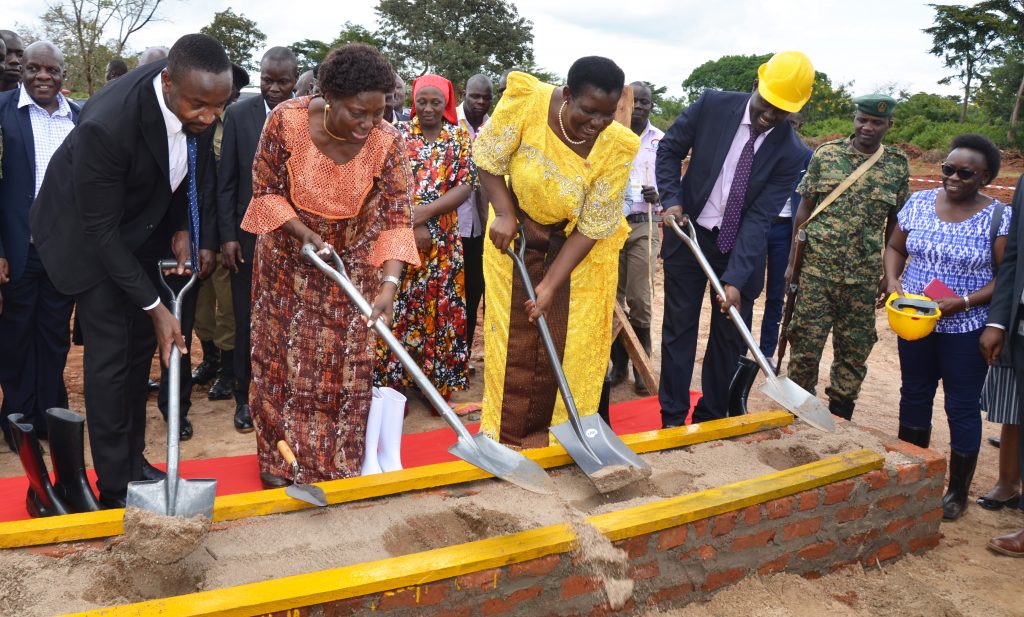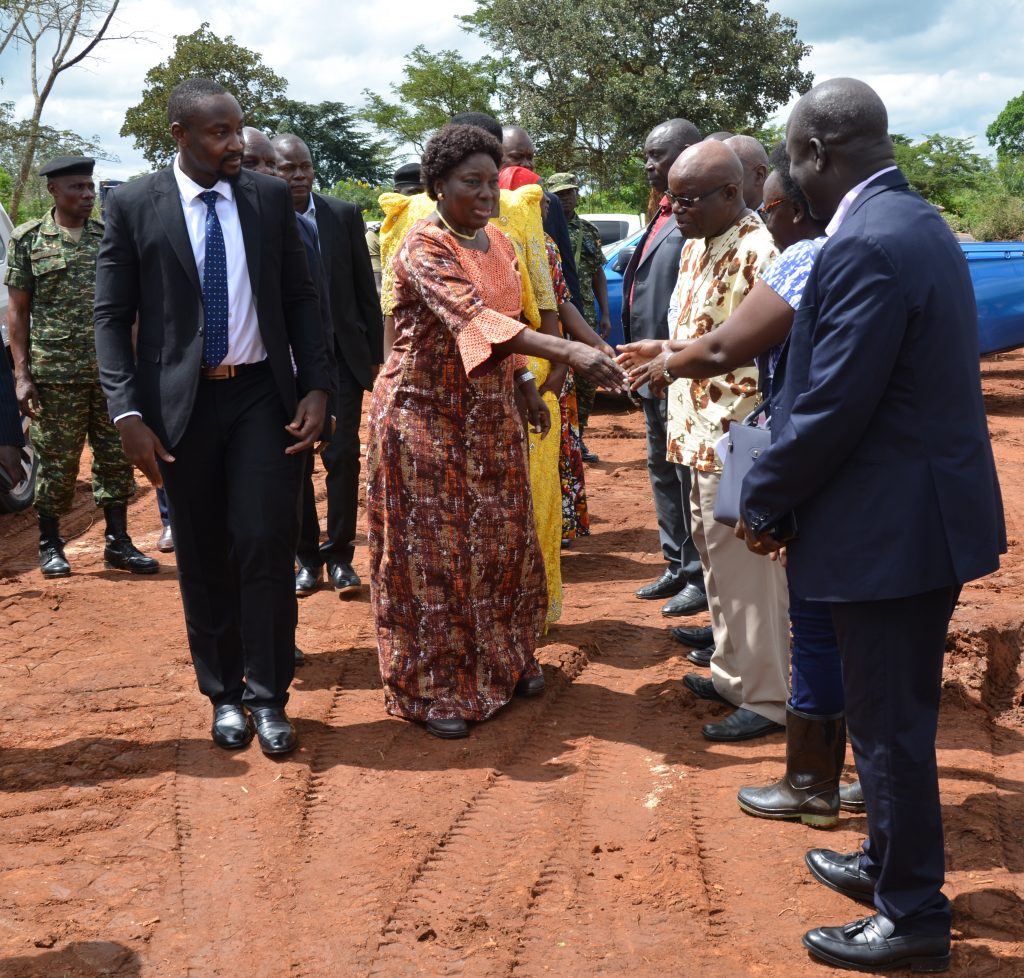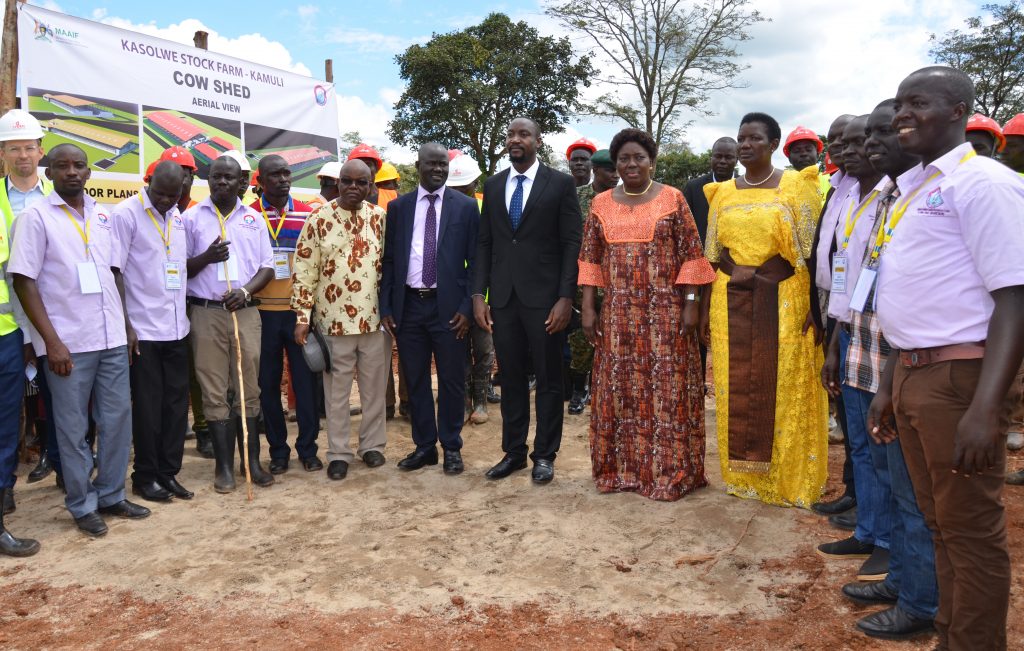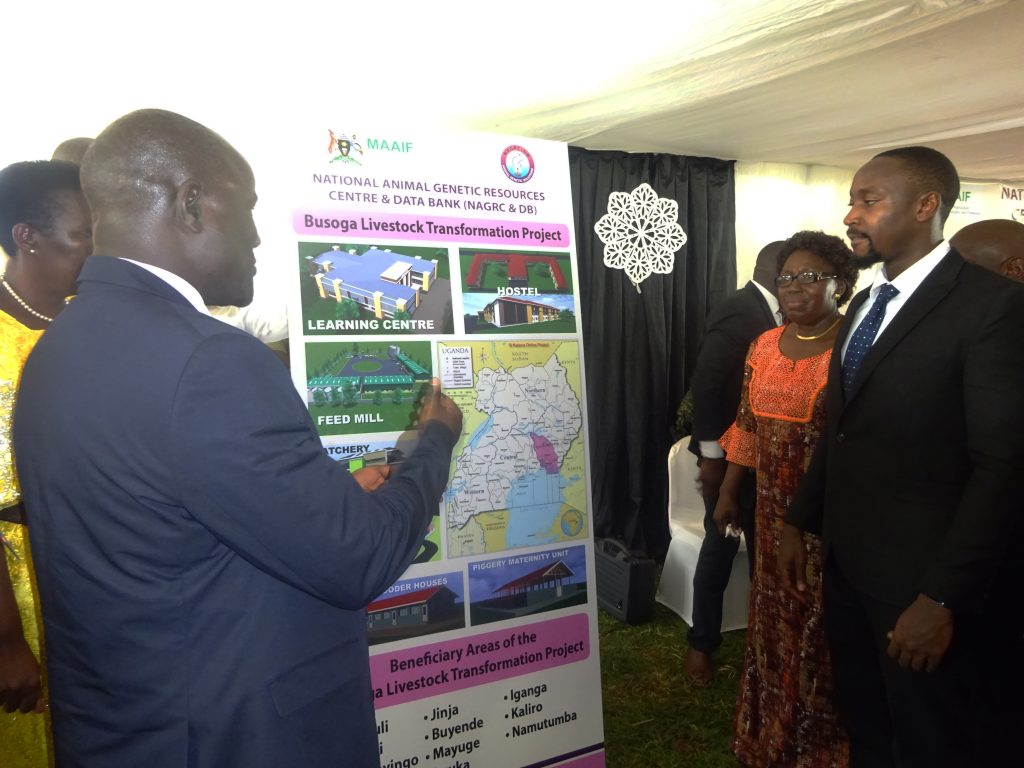
Kasolwe Stock Ranch in Kamuli District to host new livestock interventions for Busoga Sub-region
Kamuli, 30th October 2019. Kasolwe Stock Ranch in Kamuli district has hosted the Ground-breaking for new livestock interventions for Busoga region officially done by Rt. Hon. Rebecca Kadaga the Speaker of Parliament, His Royal Highness Gabula Nadiope the King of Busoga, Hon. Esther Mbayo the Minister of the Presidency, Dr. Charles Lagu the Executive Director of the National Animal Genetic Resources Centre and Databank (NAGRC&DB) and Dr. Juliet Sentumbwe the Director for Animal Resources.

These initiatives will be channeled through Kasolwe Stock Ranch in Kamuli district which is undergoing upgrade to International Standards.
The initiatives that are being channeled through the National Animal Genetic Resources Centre and Databank (NAGRC&DB) which is the livestock sub-sector Agency of the Ministry of Agriculture Animal Industry and Fisheries include the following and will be on the Ranch:
- Construction of a Cattle Dip and Spay Race
- Design and Construction of a Hay Barn will improve carcass weight from the average 150 to more than 350 per animal and will also be used for demonstrating purposes where farmers in Busoga will learn novel approaches to animal husbandry specifically nutrition.
- Improvement of Water Reticulation System at Kasolwe Stock and Construction of 4 Valley dams and 6 Valley Tanks in Busoga Area. In order to supplement on-going livestock water supply initiatives in Busoga, the project will support the construction and/or rehabilitation of livestock watering facilities with a capacity of at least 300,000 cubic meters of water for watering a day.

The districts in the region will also benefit from the following.
- Establishment of a Centre of Learning and Excellency in Livestock Farming to boost knowledge sharing for increasing productivity in Busoga
- Construction of 4 Kilometres of Farm Roads
- Connecting the farm to the National Electricity Grid
- Procurement of a milk cooling system of 5,000 litres and investment in equipment to add value to milk as the farm will be producing Yoghurt, Cheese, Butter and other value added products.

NAGRC&DB will also undertake:
- Procurement of a hatchery (100,000 egg capacity) and Brooder
- Establishment of a Fish Hatchery, 4 Brooder ponds, 20 Fish Ponds and 50 Fish Cage farms.
- Establishment of a modern piggery unit of 5,000 pigs complete with best breeds and production systems in the country.
- Introduction of 3,000 superior goats to the region
- Establishment of one model irrigation scheme to demonstrate the importance of irrigation in alleviating poverty and improving food security.

As livestock sub-sector Agency of the Ministry of Agriculture, Animal Industry and Fisheries, NAGRC&DB will also undertake the following.
- Introduction of Community Breeding Services in the 12 districts of greater Busoga Area
- Training of 100 Artificial Insemination at the sub-county level
- Introduction of Superior Breeds through Multiple, Ovulation and Embryo Transfers (MOET). Superior Cattle of preferred traits will be introduced in Busoga through MOET services. The Centre through NAGRC&DB will procure Embryos of superior genes and implant them in animals at the Centre Farm and also animals of some selected Nucleus farmers. The off springs will be animals of superior quality that will be a game changer in improving breeds in Busoga. 15,000 embryos will be procured for the above purposes.

The strategic plan that is being unpacked by NAGRC&DB also includes:
- Establishment of four Feedlots
- Support to Pasture Seed Production:The project will provide training and assistance to about a hundred (100) low-income farmers involved in farmers’associations to establish one hectare each for quality grass seed production and 300 farmers to establish 0.5 hectares each for quality legume seed production. In addition, each of the clients in the rangeland re-seeding scheme (300 farmers) and pasture improvement (500 farmers) scheme will be assisted to establish and maintain 0.5 hectares each for pasture seed multiplication. The project will provide contract pasture seed out growers with foundation seeds. These seed out growers will be contracted by private company.
- Rangelands Improvement: The project will assist 40 farmers selected on the basis of evident degraded rangelands in nine districts to serve as demonstration plots for rehabilitation of the degraded areas by clearing and re-seeding of about 10 hectares each with forage legumes and grasses. The project will adopt a mechanism for providing advisory services to livestock farmers.

The districts are also set to receive:
- Support to Improved Dry Season Feeding: This will be carried out by NAGRC&DB staff based at the Kasolwe Stock Ranch through farm demonstrations, the project will sensitize, train and assist livestock farmers in silage making, hay making, dry season utilization of crop residues and formulation and use of locally available feed supplements.
- Improvement on the genetics of Small Ruminants – 2000 Superior quality goats and 1000 sheep both meat and dairy will be moved from Nshara, Ruhengere and Rubona to Kasolwe. They will be distributed to farmers to improve genetics of local goat breeds.
- Recruitment and facilitation of 12 Livestock Extension workers – The project will recruit and facilitate livestock extension workers as the primary mechanism used to assist farmers in expanding their ability to adopt and implement new methods and to relay information to producers concerning new technologies in livestock farming.
- Collection/Dissemination of Livestock Marketing Information – The project will collaborate with the National Agricultural Advisory Services (NAADS) to collect, process and disseminate livestock marketing information and 12 District production and Trade Officers to assist in operating a sustainable livestock marketing information system.
- Training in Value-adding to Hides and Skins: The project will finance the training of 400 flayers and skinners in about 11 Districts where the project will be implemented.
Administrative units and 20 units of staff quarters will also be completed.
The rollout of livestock interventions has been targeted to suit the needs of each region of the country for address gaps and boost creation of jobs and employment especially for the youth and women.
The support for building sustainable enterprises is being provided through Business Incubation Management Support by the African Agribusiness Incubators Network which is a technical network of the African Union.
Notes for editors
About the Ministry of Agriculture, Animal Industry and Fisheries (MAAIF)
The Ministry of Agriculture, Animal Industry and Fisheries is a Ministry in the Government of Uganda charged with creating an enabling environment in the Agricultural Sector.
The Ministry formulates, reviews and implement national policies, plans, strategies, regulations and standards and enforce laws, regulations and standards along the value chain of crops, livestock and fisheries.
Vision: A competitive, profitable and sustainable agricultural sector.
Mission: To transform subsistence farming to commercial agriculture.
Strategic Objectives
- To initiate the formulation and review of the policy and legal framework for the sector
- To establish and implement systems for service provision in the sector
- To strengthen and implement strategies, regulatory framework, standards, institutional structures and infrastructure for quality assurance and increased quantities of agricultural products to access and sustain local, regional and export markets
- To design and implement sustainable capacity building programmes for stakeholders in the agricultural sector through training, re-tooling, infrastructure, provision of logistics and ICT
- To develop strategies for sustainable food security
- To develop appropriate agricultural technologies for improved agricultural production, productivity and value addition through research
- To develop effective collaborative mechanisms with affiliated institutions and
- To take lead and establish a system and institutional framework for agricultural data collection, analyses, storage and dissemination to stakeholders including Uganda Bureau of Statistics.
The Ministry of Agriculture, Animal Industry and Fisheries (MAAIF) is made up of four Directorates including the Directorate of Crop Resources, Directorate of Animal Resources, Directorate of Agricultural Extension Services and the Directorate of Fisheries Resources each with Departments, Divisions and Partnership Projects.
The Departments of the Ministry which do not fall directly in the above include the Department of Agricultural Planning and Development, the Human Resource Department, the Department of Finance and Administration and the Department of Agricultural Infrastructure, Mechanisation and Water for Agricultural Production.
The Ministry is also made up of seven Agencies including the National Agricultural Research Organisation (NARO), the National Agricultural Advisory Services (NAADS), Cotton Development Organisation (CDO), Dairy Development Authority (DDA), Uganda Coffee Development Authority (UCDA) and Coordinating Office for the Control of Trypanosomiasis in Uganda (COCTU) and the National Animal Genetic Resources Centre and Databank (NAGRC&DB).
For media-related inquiries and accreditation contact Solomon Kalema Musisi, Senior Communications Officer-Ministry of Agriculture Animal Industry and Fisheries using the email below:
About the National Animal Genetic Resources Center and Data Bank
The National Animal Genetic Resources Centre and Data Bank (NAGRC & DB) is the livestock sub-sector Agency of the Ministry of Agriculture, Animal Industry and Fisheries.
NAGRC & DB was established by the Animal Breeding Act, 2001. It’s one of the statutory semi-autonomous bodies of MAAIF. Formation of NAGRC & DB was part of the fulfilment of the aspirations in the National Animal Breeding Policy (1997) document and the action plan for its implementation, providing guidelines to all actors in the animal breeding and production value-chain. These actors include agro-input suppliers, farmers, companies, researchers, extension workers and civic leaders on suitable breeds for the various ecological and production systems. NAGRC & DB ensures national capacity development and management in the following technical areas: alternative breeding programmes; import, export and trade in genetic materials; breeding and management systems for conservation and sustainable use of indigenous genetic resources; and use of modern breeding technologies in the country. NAGRC & DB was established with a twofold mandate, namely: (i) to play a leading role in the commercialization of animal breeding activities in Uganda; and (ii) to carry out development activities that enhance animal Genetic improvement and productivity.
NAGRC & DB has eleven (11) livestock farms and ranches situated in different agro-ecological zones with varying livestock production systems. These farms serve the purpose of breeding and availing to farmers’ quality breeding stock at affordable prices. However, due to past wars and civil strife, they were impacted negatively hence leading to loss of most of the stock and destruction of key farm infrastructure. Through this project therefore, NAGRC&DB seeks to revitalize center of excellence to among other aspects support the surrounding communities with quality livestock breeds as well as build their capacity to serve as reference points/ demonstration farms for livestock farmers in aspects of animal production and farm management practices as well as export oriented production for sustainable and profitable livestock enterprises.
Community-based animal breeding programmes
Livestock breeding interventions can be planned well, designed and implemented by livestock value chain actors in cooperation with technical stakeholders to achieve efficient management of animal genetic resources for improved business development, wealth creation and sustainable livelihoods.
Community breeding models are designed to effectively allow for ownership and sustainability of animal genetic improvement efforts as well as effective utilization and conservation of animal genetic resources.
The purpose of community animal breeding programmes is to involve livestock farming communities (who are usually resource constrained and marginalized) in livestock breeding especially for the purposes of increasing production and productivity leading to improved livelihoods of poor livestock farmers.
